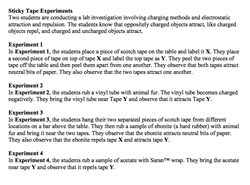 Sticky Tape Experiments
Sticky Tape Experiments
Resource:
Science Reasoning Center: Sticky Tape Experiments
Grade Level: High School
Description:
This passage describes a student experiment conducted with two pieces of sticky tape. The interaction of the tape with one another and with a variety of other objects is described. Questions target a student's ability to identify the supporting evidence for a particular conclusion, to draw conclusions that are consistent with two or more data presentations, to make predictions based upon a model, to predict the results of an additional trial, and to understand the design of an experiment.
Performance Expectation:
HS-PS1-3 Plan and conduct an investigation to gather evidence to compare the structure of substances at the bulk scale to infer the strength of electrical forces between particles.
This activity aligns with the three dimensions of the Next Generation Science Standards in the manner described below:
| Types of Interactions (HS-PS2.B.3): Forces at a distance are explained by fields (gravitational, electric, and magnetic) permeating space that can transfer energy through space. Electric charges or changing magnetic fields cause electric fields. |
By studying the electrostatics interactions (attraction and repulsion) between pieces of sticky tape in this passage, students understand that an object can experience a force without it needing to be touched by another object. The field force explored in this passage is electrical in nature. And while the concept of an electric field is not explicitly stated here, the four investigations performed serve to challenge the student to consider the nature of such electrical interactions at the macroscopic level and make inferences and draw conclusions concerning how these objects will interact in new situations. |
| Cause and Effect: Cause and effect relationships can be suggested and predicted for natural and designed systems by examining what is known about smaller-scale mechanisms within the system. |
Anytime an object attracts or repels another object, there must be a cause for such an interaction. This passage is full of such cause and effect relationships. Observations recorded from four mini-experiments serve as the data collected in this passage. After considering this data, the student is challenged to make predictions as to how the pieces of sticky tape already investigated will interact with newly introduced objects. By observing the effects (the visible attracting or repelling) on pieces of sticky tape, the causes are inferred and conclusions are drawn by the student. |
| Engaging in Argument from Evidence: Make and defend a claim based on evidence about the natural world that reflects scientific knowledge, and student-generated evidence. |
When observations of the macroscopic ‘visible world’ are the results of causes that occur at the atomic scale of the ‘invisible world,’ students need to build models to explain their observations. This passage requires students to engage in arguments from evidence of what they can observe and from the models they have constructed to predict how these objects will behave in new situations. |
Associated Reading from The Physics Classroom
Other Supporting Pages at The Physics Classroom:
View Infographic.
(Coming Soon)
Search the NGSS Corner
Maybe you're looking for something really specific that pertains to a desired topic and emphasizes one or more of the listed NGSS dimensions. Why not try a search of this section of our website? Simply select from one or more of the pull-down menus and click Search This page will reload and a collection of possibilities will be displayed in this section of the page and sorted by relevancy.